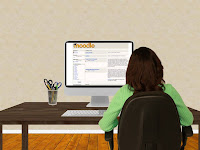
I am working on a software training project developed with Articulate where the eLearning course transitions from a branching scenario into a software simulation and I wanted to create a smooth transition from the scenario into the simulation. The scene transitions from the character sitting at a desk in front of the computer to a full screen software simulation developed with Adobe Captivate. I thought it would be cool to zoom in over the characters shoulder for a smooth transition into the full screen simulation but I wasn't quite sure how to approach this "Zoom and Pan" effect using Powerpoint animations. After a little playing around I discovered that by grouping all objects on the slide and using the "Grow/Shrink" animation I was close to achieving this effect. I figured out the Zoom but I knew there was room for improvement. I knew that with a little help from the Articulate community I could improve the effect so I recorded a Screenr video describing how I created the effect I had so far and asking for suggestions on how I could improve on it. As usual the Articulate community came up huge and responded with some great suggestions to improve the effect.
The Screenr videos below take you start to finish through the process of creating the "Zoom and Pan" transition using PowerPoint animations. The first video is what started things off and the following videos take it to the next level by using Powerpoint "Motion Paths" to add the "pan" effect and "parallel proximity." With the help of David Anderson, Kevin Thorn, and other helpful Articulate users I now have a nice transition from the scenario into the software simulation. Now that I know how to create this affect I have a lot of ideas of how to use it in other types of eLearning scenarios to bring attention to certain parts of the screen or scene that you are developing. In the spirit of sharing I have included the source files and posted the videos for anyone looking to create a similar effect. Please post a comment if you have any suggestions to improve the scene or ideas of how to use this effect in other types of eLearning scenarios.
I started things off by describing how I created the "Zoom In" effect using the "Grow/Shrink" animation. This was getting close to what I was looking for but there was still room for improvement.
(Click Here to View on Screenr)
David Anderson and Kevin Thorn both responded with the suggestion of adding a "Motion Path" to go along with the "Grow/Shrink" to achieve the Zoom and Pan effect. David Anderson describes this in the Screenr video below.
I guess I got David's wheels turning because later in the day he took it to the next level describing how to use the "Grow/Shrink" and "Motion Path" animations to create the "Parallel Proximity" effect.
(Click Here to View on Screenr)
Written Instructions:
I also received a response pointing me to written instructions from Microsoft explaining this and alternate methods of creating the "Zoom and Pan" effect.
Source Files:
If you would like to tinker around with the PowerPoint or use it for your own projects feel free to download the source files using the links below:
Related Posts:
If you are looking for tips on creating an indoor scene in eLearning like you see in the Screenr videos then check out the post at the link below:
I also received a response pointing me to written instructions from Microsoft explaining this and alternate methods of creating the "Zoom and Pan" effect.
Source Files:
If you would like to tinker around with the PowerPoint or use it for your own projects feel free to download the source files using the links below:
Related Posts:
If you are looking for tips on creating an indoor scene in eLearning like you see in the Screenr videos then check out the post at the link below:














5 comments:
Does the pixelation/fuzziness of the image bother you when it zooms in? If so, @JasonFane posted a solution at the link below.
http://screenr.com/Krp
This is great, Joe, thank you for sharing your new knowledge and the digital assets!
Personal Learning Network "roks"!
@jenisecook
This may be a silly question, but did you use a stock photo for this or did you create this image somehow?
Post a Comment